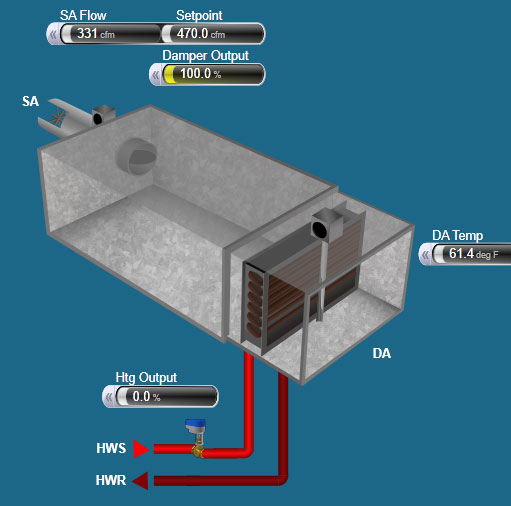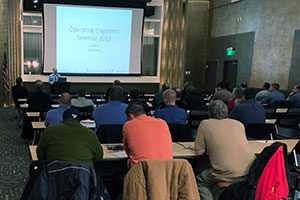Letter from the President
An important part of providing value to our customers is monitoring the trends in our industry and across various market segments. My observation is that there is one consistent, underlying theme: the changing needs and expectations of customers. With access to volumes of information on their increasingly smart and internet-connected devices, customers are expecting more. They are leveraging their access to information and new tools and insights to take more control over their decisions.
As the energy systems built by our grandparents are being transformed to more responsive and personalized networks, the expectations of energy consumers are also changing. When District Energy St. Paul started 35 years ago our customer buildings did not have an automated building management systems. Today a majority of our customers use digital and even cloud-based building automation and management tools. Systems that put a wealth of real-time data at the fingertips of operators and owners. This data can be insightful, but it can also be a bit overwhelming to turn this data into information that can drive better system performance.
We know that an increasing percentage of our customers want to be on top of their energy usage, so they can use less and save money. This frequently means sifting through multiple data points to find answers. Working with our customers directly, we have seen many approaches to this analysis, and we have helped to identify specific solutions to make equipment and systems run more efficiently and effectively. This year we completed a multi-year effort to upgrade all customer primary meters to 1-minute data, and we are able to rapidly access the data on those meters. This investment is enabling us to help customers troubleshoot underperforming building systems and tune the performance to increase efficiency. District Energy customers can also integrate outputs from our meter directly into our customer’s building management system to analyze and control their energy use. As we continue to test and integrate new technologies, we are focusing on solutions that are reliable and cost-effective for our customers.
If you would like to learn more about integrating District Energy meter data into your system, or if you have a question about the tools available to you, please contact our customer service team at 651.297.8955.
333 on the Park
Last spring, new residents were welcomed home to 333 on the Park. District Energy was happy to welcome this beautiful apartment building as the 41st residential building on our system, providing it with cooling, heating, and domestic hot water.
 A historic renovation, the building has been transformed into a 134-unit luxury apartment complex situated in the heart of the Artist District between Mears Park and the Union Depot. 333 on the Park offers studio, 1, 2, 3-bedroom, and penthouse apartments with high-end finishes. A few of the building amenities including a yoga studio, concierge, 24-hour fitness center, artist gallery, sky lounge, large community room, underground parking, and of course district heating and cooling. District Energy services are new to many of the tenants. From the sounds of it, they are quite pleased. Calsey Smith, Community Manager for 333 on the Park says, “The bills don’t lie. The residents are happy to see their utility bills much lower than the other properties that they have lived in previously.” The building operators and managers were also new to the system. They are extremely grateful for the outstanding customer support District Energy has provided during this learning period. “All of our questions and concerns are always answered immediately. Customer service is always quick to walk us through an issue or come on site to show us how,” stated Calsey.
A historic renovation, the building has been transformed into a 134-unit luxury apartment complex situated in the heart of the Artist District between Mears Park and the Union Depot. 333 on the Park offers studio, 1, 2, 3-bedroom, and penthouse apartments with high-end finishes. A few of the building amenities including a yoga studio, concierge, 24-hour fitness center, artist gallery, sky lounge, large community room, underground parking, and of course district heating and cooling. District Energy services are new to many of the tenants. From the sounds of it, they are quite pleased. Calsey Smith, Community Manager for 333 on the Park says, “The bills don’t lie. The residents are happy to see their utility bills much lower than the other properties that they have lived in previously.” The building operators and managers were also new to the system. They are extremely grateful for the outstanding customer support District Energy has provided during this learning period. “All of our questions and concerns are always answered immediately. Customer service is always quick to walk us through an issue or come on site to show us how,” stated Calsey.
333 on the Park was formerly known as The Gordon & Ferguson building. Constructed in 1913 and designed by Clarence H. Johnston Sr., a prominent Saint Paul architect. It was the original headquarters for entrepreneurs Richard Gordon and Paul Ferguson who dealt in hats. Their business grew to become the outdoor clothing line under the brands Field & Stream and Town & Country.
Conveniently located in Lowertown, there are still a few of these gorgeous apartments available with outstanding views of the Mississippi River – be sure to schedule a tour today.
Ask the Engineer – Getting the Most out of Your Building Automation System Part 2
This is the second of two articles that focused on your building automation system. In this article, we will share some suggestions on using warnings to monitor system conditions. By taking some time to set up warnings on control points, you can use real-time building automation system information to identify which piece of equipment requires the attention of building operators before the issues turn into occupant complaints.
Alarms are a very common part of any automation system. They are used to tell building operators when things are too hot, too cold, when the command of an object does not match the status of the object, and many other conditions. What alarms will not do is allow operators to see when things are not properly controlling before they get outside of the allowable operating parameters. Setting up warnings on control points fills this gap.
Warnings are best used on analog outputs like damper commands, valve commands, pumps and fan speed outputs, as well as, PID loop values like cooling demands, heating demands, or static pressure resets. Warnings do not work for two-position equipment that require the control device to be on or off, nor will it work for equipment in series where one device is supposed to completely open before a second device starts to open. One example of this could be a 1/3 valve 2/3 valve operation.
Warnings can be setup in many ways but one common way is to add a warning to a point that is at 100% of its control range. In an effort to maintain control, the point has gone to its extreme position and is, or will likely soon be, letting the control variable drift out of the correct range. Examples of this would be a radiation valve that is 100% open but the room temperature continues to drop or a VAV-box that is providing 100% of the design air flow but the temperature is still increasing in the space. Figure 1 shows a VAV box that is 100% open but is shy of its design air flow by 30%.

Figure 1: VAV with reduced airflow
Johnson Controls, Metasys® Building Automation System, screen capture from District Energy’s Jemne office
Catching issues like this will help to prevent uncomfortable indoor conditions and reduce excess energy usage before they become major failures. In this reduced air flow example, the issue could be related to a reheat coil that has become coated with dust and debris and is no longer allowing enough air through the coil or it could be play or slack in the damper linkage. Regardless of the issue, a physical examination of the equipment is the only way to determine the problem.
Setting up warnings on your building automation system is another tool that building operators can use to monitor and manage building equipment. In the first article, we shared some suggestions on using totalizers to verify equipment run time and using pressure independent valves to monitor energy. If you have questions about energy savings opportunities or your District Energy connection, please contact the customer service team at 651.297.8955 or info@districtenergy.com.
Cyber Security
Cyber security is a significant priority for most companies these days, as the general security environment is changing on a nearly constant basis. At District Energy, we recognize that security is a core element of our system reliability, and therefore we have put substantial effort into developing our security program over the years. The program is based on industry standards with necessary customization for the needs of our business and systems.
Our security program touches all levels of our information infrastructure including network systems, policies, monitoring protocols, staff training, and ongoing communication. Business networks and industrial controls systems require different methods to secure them and our program addresses these differences. Our team also has the ability to tailor security measures between operating sites, as needed, to meet unique security requirements. Our company’s leadership is committed to making cyber security a top priority on an ongoing basis, evolving to respond to an ever-changing environment while making sure that we continue to provide reliable services to our customers.
Saint Paul Building Engineers Attend Seminar
 In early November we hosted engineers from our customer buildings for the annual Operating Engineers Seminar. Engineers Jeff Volovsek and Bob Ford presented information and solutions to help customers save energy as well as how to incorporate recent code changes for heat recovery and the best practices for process cooling. Tom Thomalla, Senior Information Technology Manager, also shared an overview of the cyber security initiatives at District Energy. This event was a great opportunity to connect with building operators. The presentation from the event is available here. Thank you to all who attended.
In early November we hosted engineers from our customer buildings for the annual Operating Engineers Seminar. Engineers Jeff Volovsek and Bob Ford presented information and solutions to help customers save energy as well as how to incorporate recent code changes for heat recovery and the best practices for process cooling. Tom Thomalla, Senior Information Technology Manager, also shared an overview of the cyber security initiatives at District Energy. This event was a great opportunity to connect with building operators. The presentation from the event is available here. Thank you to all who attended.
If you have questions about these topics or your District Energy interface, you can contact Jeff and Bob for assistance by calling 651.297.8955.
District Energy’s A- Bond Rating Confirmed by Standard and Poor’s
At District Energy we have focused on our operational process to manage our assets and to follow sound financial practices, because our financial strength directly impacts our customers and our system. This priority has helped us to keep our rates steady, while continuing to make investments in system upgrades.
This past month, our team was able to validate our approach to financial stewardship by affirming the A-/Stable rating we received in 2013 from Standard & Poor’s (S&P). S&P affirmed its long-term rating of A-/Stable for the 2017 Series 2017-3, 2017-4, (Taxable) Series 2017, Cooling Series 2013 A-E and Heating Series 2013-A-E revenue bonds.
The rating review reflects a series of credit strengths, including stable revenue under long-term contracts with a fairly diverse customer base, cost base rates that are adjusted annually to fully recover costs (including debt service) and an energy charge that can be adjusted monthly if necessary to recover changes in the cost of fuels, and well-managed assets, which are reliable and competitively priced. The A- rating is significant within the utility industry. Investment grade ratings of BBB- or above are seen as a major threshold for business stability and financial continuity.
